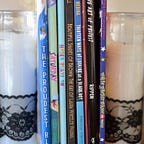Good Trouble For Kids—Sulwe, by Lupita Nyong’o
—Delia LaJeunesse
Visual Literacy
Visual literacy can be an incredible tool in deepening the context of a piece of media (news, book, story, movie), engaging with subject matter on an intuitive and emotional level, and connecting meaningfully with social causes. Unfortunately, arts literacy is not something that is taught to us, we have to seek it out. Learning how to “read” visual art offers an opportunity to integrate the power of these books, engage your intuitive understanding, and expand the imagination to truly en vision the future we want to see.
My approach to this book
Oh I adored this book. What a stunning exploration of color, of darkness, of shade, of beauty. This book was so empowering. It brought to mind an ongoing conversation that I seem to be having with art and the subtle valuation of light vs. dark.
I wrote about this recently in a book for older kids, A Wreath For Emmett Till:
“I cannot help, every time I see it, but be bothered by the symbolism of white equalling innocence and purity. I see this so often, and feel strongly that we need to become aware of, and address this motif. Esthetics are culturally learned. I want an esthetic of deep rich soil as purity. I want an esthetic of heavy black fabrics as innocence, as protection. I want the esthetics flipped I want the dark and mysterious to be the space of grace.
It is not possible for me to separate a discussion of race from the idea of black being scary and treacherous, and white being pure and innocent. Not, at the very least, while we still call each other black and white people. I do not think we are so sophisticated as to separate these two meanings. And I don’t mean to put down human intelligence, but I do think this subtle esthetic value system is by design and I cannot help but revolt against it. I think that this is the subtlety of white supremacy (note the language) as well as a white christian esthetic still dripping into our visual vocabulary.”
Sulwe is a corrective.
Here, we have a book that directly attests to the holiness of a deep, velvety dark. A book that gives value and beauty to the night, so often disregarded (we speak about beautiful days all of the time, rarely about beautiful nights). The night is representative of the unknown, of the creative, of the divine feminine. As Nyong’o says, “we need the darkest night to get the deepest rest. We need you so that we can grow and dream and keep our secrets to ourselves” Yes. Secrets, dreaming and rest. These three values are so vital to a restored world. They reside within the feminine because of their generative qualities, and, like the feminine, have been pushed out of the limelight in favor of the more masculine notions of certainty, logic and productivity.
This book reminds me vividly of the cover of Vanity Fair with Viola Davis, photographed by Dario Calmese
“The image speaks to changing the “white gaze on Black bodies, and transmuting that into something of elegance and beauty and power,” Calmese told the Times.”
In this image, we have a rich esthetic of deep, silky, glorious darkness.
As bell hooks argues in her phenomenal book, Art on My Mind, “aesthetics nurture the spirit and provide ways of rethinking and healing psychic wounds inflicted by assault from the forces of imperialism, racist and sexist domination.”
Nyong’o, Calmese and so many others are working to correct our cultural esthetics, and I feel grateful for their contributions in changing the tide. I hope that we as audiences and recipients of cultural works contribute to this shift by becoming increasingly aware of visual politics, and taking note of our subtle attribution to values like good and bad to white and black.
